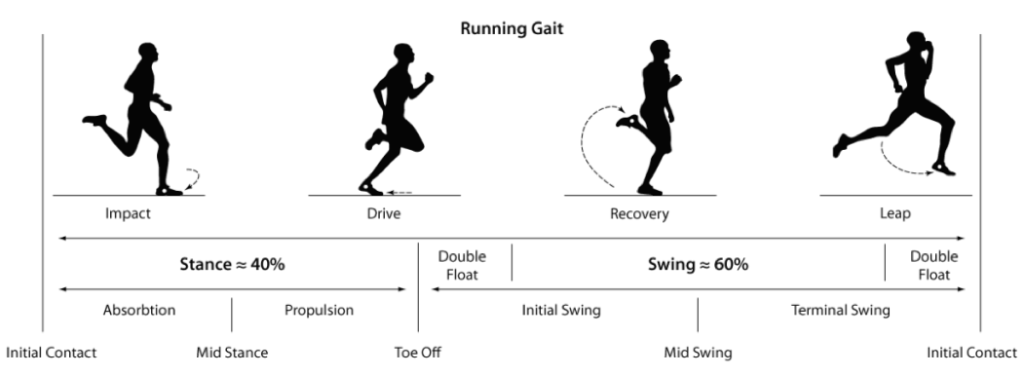The Run Centre: 4-Point Run Analysis
The 4-Point Run Analysis is our research-based approach to helping you enjoy the run experience. The goal of this run analysis was to provide a quick, but thorough, summary of a runner’s gait to give insights on which running shoe functional elements might be best suited to help improve efficiency or reduce tissue load. The best part is IT’S FREE!
Using the high-speed camera built into the latest generation of Apple’s iPad, the 4 points of our run analysis include examining a runner’s gait at touch down, full weight acceptance, swing phase, as well as determining the runner’s step-rate.

Touch Down
The posture of the leg and foot at initial touch down provides important insight into how the body is prepared to ‘accept’ body weight through stance. Examining what part of the foot makes contact with the ground is the basis of looking at touch down posture. As their names suggest, a rear-foot striker would have their heel strike the ground first; a mid-foot striker would strike the ground at either their mid- or forefoot.
The position of the leg at Touch Down is important as it tells us important information about how much loading we can expect through the ankle, knee and hip during stance. Touch Down posture can even tell us when we can expect certain joints (and their associated muscles and tendons) to undergo their maximal loading.
Weight Acceptance
This is the bread and butter of classic running injury theory: to examine how much the foot flattens during mid-stance; the greater the flattening, the greater the risk of injury. We now recognize, however, that this greatly oversimplifies injury patterns in runners 1.
Nevertheless it was worth examining how medially deviated the mid-foot is during weight acceptance as it may be a factor in specific injuries, such as anterior knee pain and ankle pain.
Swing Phase
Swing phase sets the tone for the whole running gait cycle and prepares the body’s posture for touch down. Swing phase can be divided into three distinct phases: initial, middle, and terminal swing. Initial swing or ‘follow-through’ is the time immediately following toe-off until the final point of posterior movement of the foot. Middle or forward swing phase is the time during all forward (anterior) movement of the foot. Terminal swing takes place while the foot descends to the ground.
In general, it is advantageous to have increased knee flexion (i.e. ‘high’ leg swing) during the first two phases of swing in order to reduce the moment-arm at the hip, improve running economy 2 , and reduce loading at the hip and lower-back.
Terminal swing is also important in preparing the lower-extremity for weight acceptance 3. It is advantageous to have some degree of knee-flexion as the foot approaches the ground that encourages closer foot contact with the centre of mass and promotes preparatory muscle activation.
Step Rate
Step rate is the number of times your foot comes into contact with the ground. Changing step rate is a very powerful way of changing how the runner should position their leg in stance. Increasing step rate (without changing speed) requires a runner to shorten their stride length and place their foot more directly underneath their body at touch down that can significantly reduce loads at the knees, hips and lower back.
Increasing your step-rate by 10%, regardless of your initial step-rate, can reduce the loads through your kneecap and hips by 2-3 times 4!
To learn more about our 4-Point Run Analysis, stop by The Run Centre and get your free assessment today!
References
[1] Ryan M, et al. The effect of three different levels of footwear stability on pain outcomes in women runners: a randomized control trial. Br J Sports Med 2011; 43(2): 296-302.
[2] Williams K.R. & Cavanagh P.R. Relationship between distance running mechanics, running economy, and performance. J Appl Physiol. 1987;63(3):1236-45.
[3] Chumanov E.S. et al. Changes in muscle activation patterns when running step rate is increased. Gait Posture 2012;36:231-35.
[4] Heiderscheit B, et al. Effects of Step Rate Manipulation on Joint Mechanics during Running Medicine and Science in Sports and Exercise 2011; 43(2):296-302

Kristinn Olafsson
April 11, 2019 at 2:35 amHello my name is Kristinn and I am in University of Iceland studying master in physical therapy.
I am doing my final essay about how fatigue effects range of motion in knee.
Is I allowed to have the running circle in my essay?
Best Regards: Kristinn
Andreas I
June 7, 2020 at 1:57 amHello – my name is Andreas, and im writing a paper to my exam as physiotherapist.
Is it allowed to use your picture of running gait?
Michael Ryan - Director of R&D
June 8, 2020 at 10:08 amHi Andreas – Please contact me directly for this request at [email protected]. Thank you